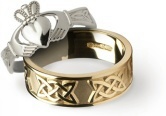Saint Patrick
Though St. Patrick’s Day is perhaps best known for shamrocks and has become rather an excuse to overindulge in green beer, this holiday was meant to celebrate a real saint whose life had a significant impact on Ireland and Christianity.
The patron saint of Ireland is Saint Patrick, born Maewyn Succatto the son of wealthy parents in Scotland sometime late in the fourth century. He lived there until, at the age of sixteen, he was taken as a prisoner by some Celtic marauders who were attacking his family’s extensive lands. He was taken back to Ireland and spent six years as a shepherd in the Irish countryside. It was lonely work for a young boy who was undoubtedly fearful about these changes in his life, and it is while he was tending his flocks that he turned to God for comfort and became a Christian. God spoke to him and he was able escape and return to his home, where he later felt called by God to return to Ireland as a missionary. St. Patrick is estimated to have established more than 300 churches and converted more than 135,000 Irish people to Christianity, making him a beloved figure in Ireland’s rich history.
The Celts were quite superstitious and pagan-worshiping people, so in order to convert them the man who became known as St. Patrick used many of the elements of their own pagan rituals to convert them to Christianity. For example, he added the image of the sun to the traditional Christian cross in order to appeal to the pagans who celebrated their gods through nature. This is now known as the Celtic cross.
The pagan rituals also used fire to show honor to their gods, so he used fire to teach them about Easter as well as to defy the pagan gods. During their ritual to welcome spring, the pagans insisted that no other fires be lit so that the ritualistic fire they lit on a hill would both literally and symbolically be the only source of light, heat and life in the country. St. Patrick is supposed to have climbed a nearby hill, the Hill of Slane, and lit his own Paschal fire in defiance of this pagan practice, thus shedding the symbolic light of Christ to the world.
One of the primary symbols associated with St. Patrick is the shamrock, a three-leafed clover. The shamrock was a sacred plant used by the Druids in their pagan worship; in keeping with his practice of converting Celtic pagan elements to Christian symbols, St. Patrick used the shamrock to represent the Holy Trinity, a visual representation of the Father, Son and Holy Ghost. This may be true, but it may also simply be a myth perpetuated by monks in the Church centuries after the fact.
Another legend associated with St. Patrick concerns snakes. It is a commonly held belief that St. Patrick single-handedly rid the country of Ireland of snakes, and indeed there are no snakes in Ireland. The truth is, however, that Ireland has never had snakes. It is an island surrounded by the frigid ocean water, and any snakes would have had to be imported. The myth has likely been perpetuated as an effective metaphor for St. Patrick’s ridding the country of the “evil” of paganism by ridding it of symbolically evil snakes.
St. Patrick is considered to be the man who introduced alcohol, in the form of beer, to Ireland, which of course is one reason why drinking beer is such an integral part of the day’s celebrations. An average of 5.5 million pints of Guinness, a renowned Irish stout, are consumed worldwide each day; on St. Patrick’s Day, that number increases to 13 million pints, many of which are dyed green to honor the Irish saint.
The celebration of St. Patrick’s Day was a simple feast day in Ireland until just a few decades ago when the country began changing its celebrations to reflect what was happening in America. Now the celebrations in Ireland span five days and are filled with entertainment of all kinds as well as elements of Irish history and culture. Of course anyone who would like to come to Ireland and celebrate will be warmly welcomed.
Though records of St. Patrick’s Day celebrations in America, including parades, date back to the Revolutionary War era, it was not until the late 1800s when Irish immigrants in some of America’s largest cities turned the humble feast day into festive celebrations of Irish heritage. March 17 became a day filled with parades and other colorful green reminders of the immigrants’ proud Irish heritage. Since then, this holiday has become a celebration of ethnic identity and solidarity in which people of all ethnicities and all countries are welcome to participate.
Because so many Irish people have had to leave their country during times of great famine over the centuries, people of Irish descent can be found in nearly every part of the world. Those with Irish heritage in Australia celebrate this holiday for eight days, and New Zealanders celebrate their Irish heritage beginning with a grand social gala called the Emerald Ball followed by days of outdoor activities and sports. Japan holds a St. Patrick’s Day parade in which more than 500 people participate, and the places in South America and the Caribbean with a history of Irish immigration also enjoy local festivities to celebrate the day.
In addition to being a day to celebrate the coming of spring, March 17 has become a day to wear green, attend parades, dye rivers green and drink green beer. Clearly St. Patrick’s Day is also a much-loved holiday which has plenty of cultural and historic significance both to Ireland and to Christianity.
